Planning for Growth
VerifiedAdded on 2023/01/09
|18
|4860
|94
AI Summary
This document discusses growth planning and evaluating growth opportunities for SMEs. It explores considerations for evaluating growth opportunities, Ansoff Matrix, alternative sources of funds, and creating a business plan. The document also includes a case study on CafePod Coffee Co.
Contribute Materials
Your contribution can guide someone’s learning journey. Share your
documents today.
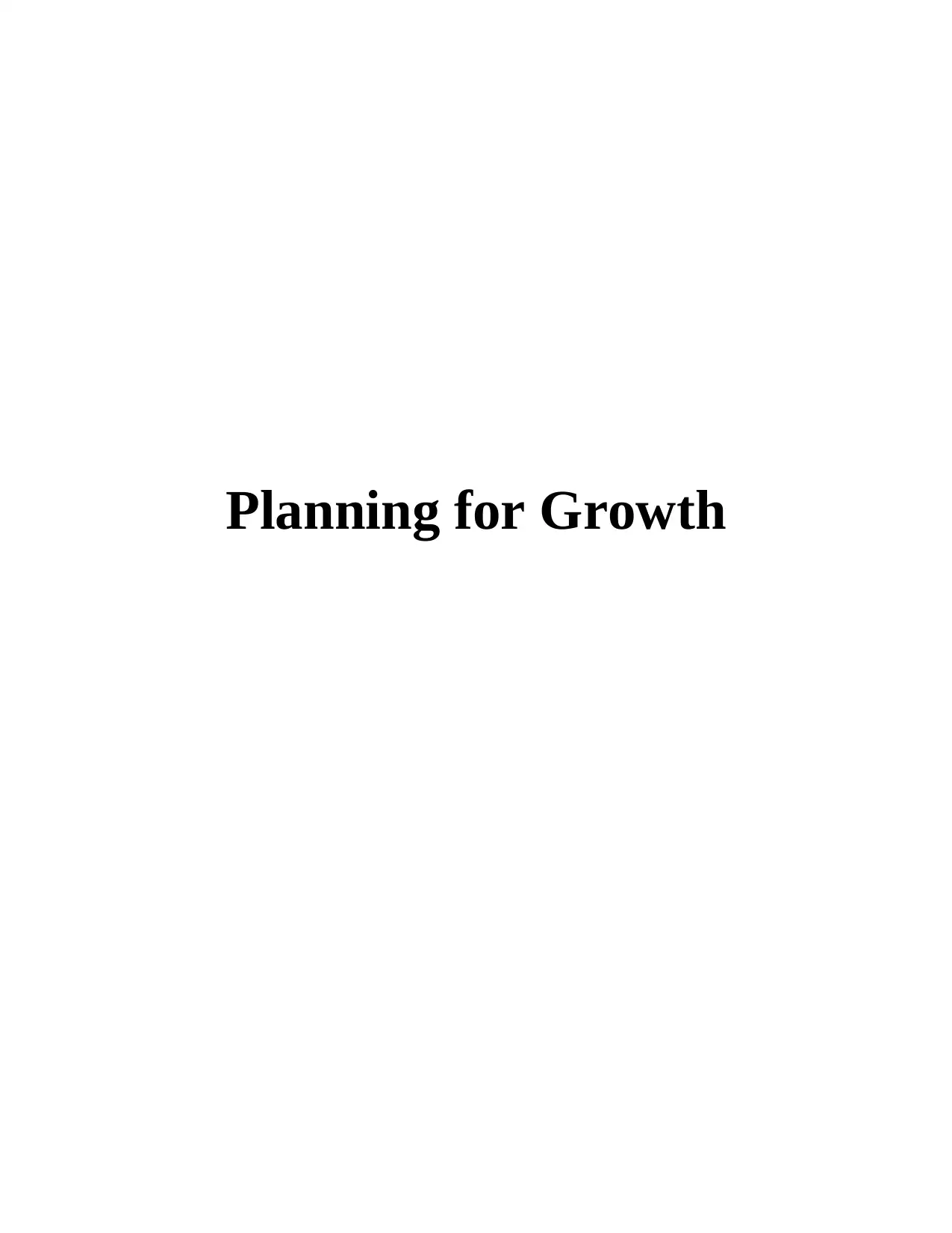
Planning for Growth
Secure Best Marks with AI Grader
Need help grading? Try our AI Grader for instant feedback on your assignments.
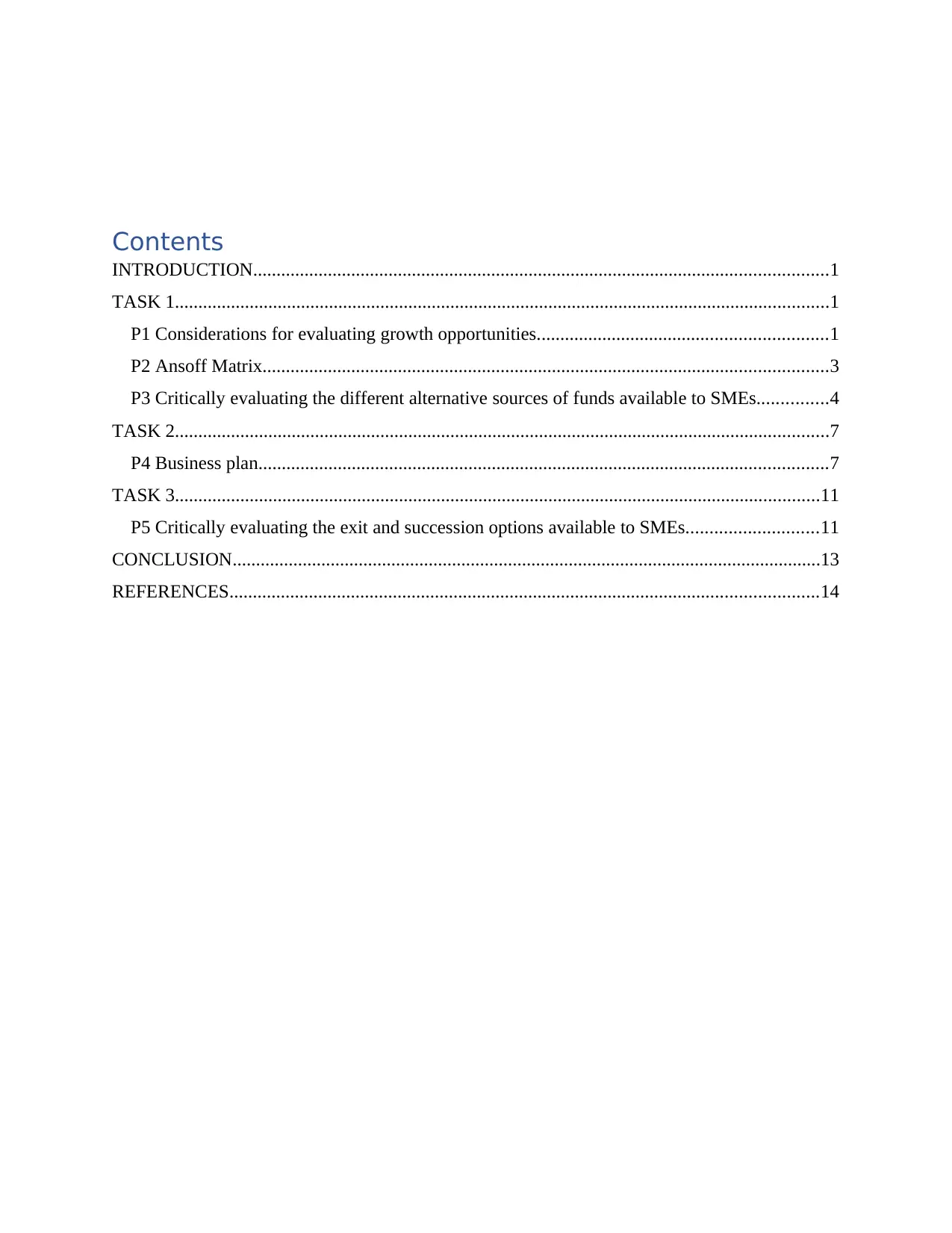
Contents
INTRODUCTION...........................................................................................................................1
TASK 1............................................................................................................................................1
P1 Considerations for evaluating growth opportunities..............................................................1
P2 Ansoff Matrix.........................................................................................................................3
P3 Critically evaluating the different alternative sources of funds available to SMEs...............4
TASK 2............................................................................................................................................7
P4 Business plan..........................................................................................................................7
TASK 3..........................................................................................................................................11
P5 Critically evaluating the exit and succession options available to SMEs............................11
CONCLUSION..............................................................................................................................13
REFERENCES..............................................................................................................................14
INTRODUCTION...........................................................................................................................1
TASK 1............................................................................................................................................1
P1 Considerations for evaluating growth opportunities..............................................................1
P2 Ansoff Matrix.........................................................................................................................3
P3 Critically evaluating the different alternative sources of funds available to SMEs...............4
TASK 2............................................................................................................................................7
P4 Business plan..........................................................................................................................7
TASK 3..........................................................................................................................................11
P5 Critically evaluating the exit and succession options available to SMEs............................11
CONCLUSION..............................................................................................................................13
REFERENCES..............................................................................................................................14


INTRODUCTION
Growth planning refers to the managerial process of determining growth opportunities and
evaluating multiple opportunities to determine the best possible pursuit for business growth and
development in future (Osiyevsky and et. al., 2013). CafePod Coffee Co. is an independent
company which was founded in the year 2011 and the headquarters of the company are located at
Portsmouth, England. It offers a wide range of coffee products (Cafepod Coffee, 2020). The
report determines growth opportunities for SMEs in United Kingdom and evaluate different
growth opportunities using analytical tools. The report also evaluates the alternative sources of
funding available to SMEs and different exit or succession strategies. A business plan for future
growth and development of CafePod Coffee Co. is also being prepared in the report.
TASK 1
P1 Considerations for evaluating growth opportunities.
Growth opportunity is usually a potential investment opportunity to increase the sales and
revenue of a business organisation that may arise due to external environment factors or internal
strengths and opportunities for the organisation. In United Kingdom, an organisation that
employs fewer than 250 employees with the annual revenue not more than £40 Million is knows
as SME. A very significant contribution is made by SMEs in the economic growth and
development of a country by generation of employment opportunities, bringing in foreign
investment and increasing the pace of development. Hence, opportunities for business growth
and development hold crucial significance for SMEs with combined motive of economic growth
of the country as well as the market favourability and supportiveness for small business owners
in light of the increasing extent of competition in the business environment (Moutray, 2009).
Before evaluation of any growth opportunity, following considerations should be made by the
management of CafePod Coffee Co. or any business owner of SME:
Resources: Determination and consideration of the resources that are essential for
business growth and development is an important consideration to be made by business
managers of SMEs before evaluation of any growth opportunity (Wiklund and Shepherd, 2003).
For example, access to technical and other financial resources is important for leveraging growth
by making investment into business opportunity.
1
Growth planning refers to the managerial process of determining growth opportunities and
evaluating multiple opportunities to determine the best possible pursuit for business growth and
development in future (Osiyevsky and et. al., 2013). CafePod Coffee Co. is an independent
company which was founded in the year 2011 and the headquarters of the company are located at
Portsmouth, England. It offers a wide range of coffee products (Cafepod Coffee, 2020). The
report determines growth opportunities for SMEs in United Kingdom and evaluate different
growth opportunities using analytical tools. The report also evaluates the alternative sources of
funding available to SMEs and different exit or succession strategies. A business plan for future
growth and development of CafePod Coffee Co. is also being prepared in the report.
TASK 1
P1 Considerations for evaluating growth opportunities.
Growth opportunity is usually a potential investment opportunity to increase the sales and
revenue of a business organisation that may arise due to external environment factors or internal
strengths and opportunities for the organisation. In United Kingdom, an organisation that
employs fewer than 250 employees with the annual revenue not more than £40 Million is knows
as SME. A very significant contribution is made by SMEs in the economic growth and
development of a country by generation of employment opportunities, bringing in foreign
investment and increasing the pace of development. Hence, opportunities for business growth
and development hold crucial significance for SMEs with combined motive of economic growth
of the country as well as the market favourability and supportiveness for small business owners
in light of the increasing extent of competition in the business environment (Moutray, 2009).
Before evaluation of any growth opportunity, following considerations should be made by the
management of CafePod Coffee Co. or any business owner of SME:
Resources: Determination and consideration of the resources that are essential for
business growth and development is an important consideration to be made by business
managers of SMEs before evaluation of any growth opportunity (Wiklund and Shepherd, 2003).
For example, access to technical and other financial resources is important for leveraging growth
by making investment into business opportunity.
1
Paraphrase This Document
Need a fresh take? Get an instant paraphrase of this document with our AI Paraphraser
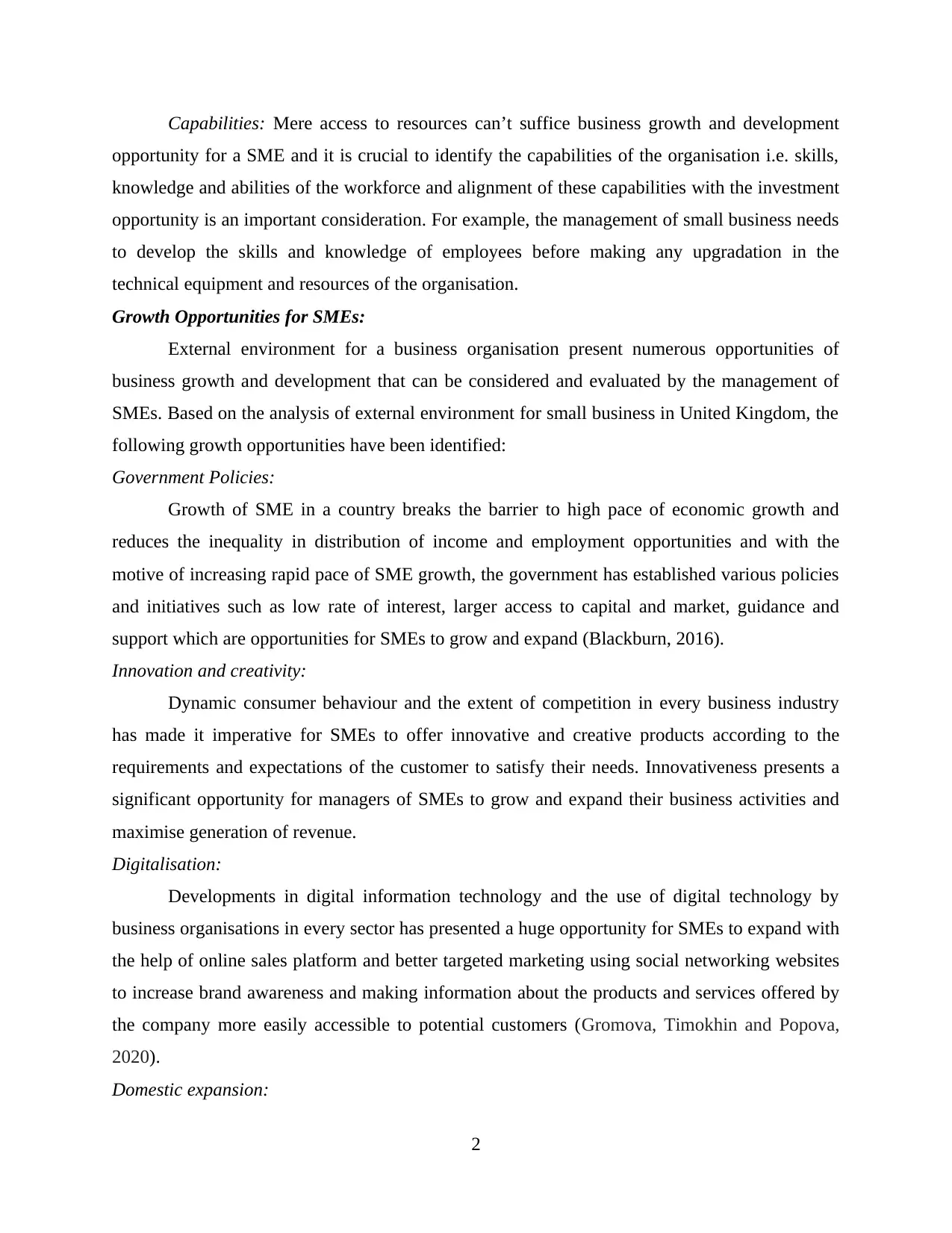
Capabilities: Mere access to resources can’t suffice business growth and development
opportunity for a SME and it is crucial to identify the capabilities of the organisation i.e. skills,
knowledge and abilities of the workforce and alignment of these capabilities with the investment
opportunity is an important consideration. For example, the management of small business needs
to develop the skills and knowledge of employees before making any upgradation in the
technical equipment and resources of the organisation.
Growth Opportunities for SMEs:
External environment for a business organisation present numerous opportunities of
business growth and development that can be considered and evaluated by the management of
SMEs. Based on the analysis of external environment for small business in United Kingdom, the
following growth opportunities have been identified:
Government Policies:
Growth of SME in a country breaks the barrier to high pace of economic growth and
reduces the inequality in distribution of income and employment opportunities and with the
motive of increasing rapid pace of SME growth, the government has established various policies
and initiatives such as low rate of interest, larger access to capital and market, guidance and
support which are opportunities for SMEs to grow and expand (Blackburn, 2016).
Innovation and creativity:
Dynamic consumer behaviour and the extent of competition in every business industry
has made it imperative for SMEs to offer innovative and creative products according to the
requirements and expectations of the customer to satisfy their needs. Innovativeness presents a
significant opportunity for managers of SMEs to grow and expand their business activities and
maximise generation of revenue.
Digitalisation:
Developments in digital information technology and the use of digital technology by
business organisations in every sector has presented a huge opportunity for SMEs to expand with
the help of online sales platform and better targeted marketing using social networking websites
to increase brand awareness and making information about the products and services offered by
the company more easily accessible to potential customers (Gromova, Timokhin and Popova,
2020).
Domestic expansion:
2
opportunity for a SME and it is crucial to identify the capabilities of the organisation i.e. skills,
knowledge and abilities of the workforce and alignment of these capabilities with the investment
opportunity is an important consideration. For example, the management of small business needs
to develop the skills and knowledge of employees before making any upgradation in the
technical equipment and resources of the organisation.
Growth Opportunities for SMEs:
External environment for a business organisation present numerous opportunities of
business growth and development that can be considered and evaluated by the management of
SMEs. Based on the analysis of external environment for small business in United Kingdom, the
following growth opportunities have been identified:
Government Policies:
Growth of SME in a country breaks the barrier to high pace of economic growth and
reduces the inequality in distribution of income and employment opportunities and with the
motive of increasing rapid pace of SME growth, the government has established various policies
and initiatives such as low rate of interest, larger access to capital and market, guidance and
support which are opportunities for SMEs to grow and expand (Blackburn, 2016).
Innovation and creativity:
Dynamic consumer behaviour and the extent of competition in every business industry
has made it imperative for SMEs to offer innovative and creative products according to the
requirements and expectations of the customer to satisfy their needs. Innovativeness presents a
significant opportunity for managers of SMEs to grow and expand their business activities and
maximise generation of revenue.
Digitalisation:
Developments in digital information technology and the use of digital technology by
business organisations in every sector has presented a huge opportunity for SMEs to expand with
the help of online sales platform and better targeted marketing using social networking websites
to increase brand awareness and making information about the products and services offered by
the company more easily accessible to potential customers (Gromova, Timokhin and Popova,
2020).
Domestic expansion:
2
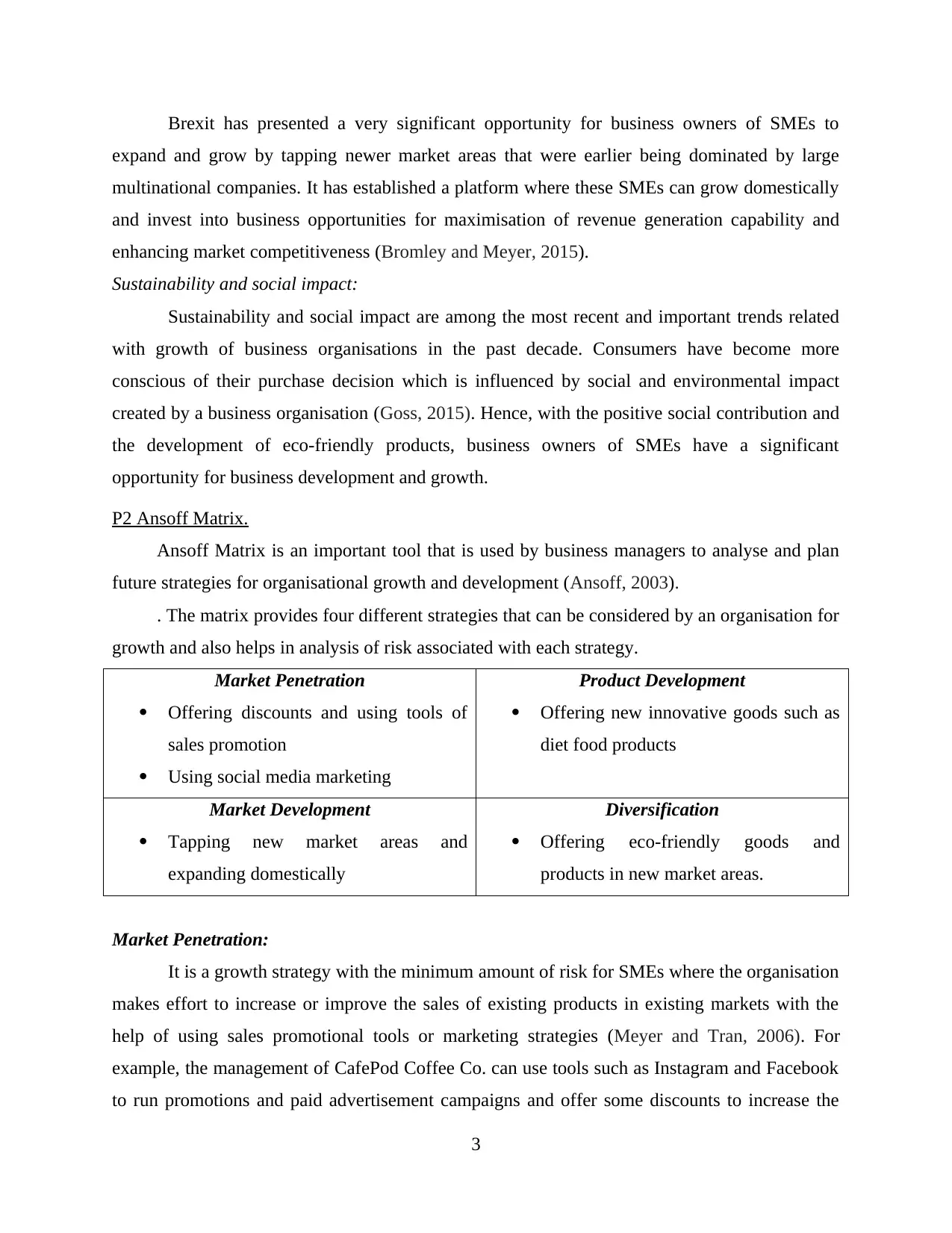
Brexit has presented a very significant opportunity for business owners of SMEs to
expand and grow by tapping newer market areas that were earlier being dominated by large
multinational companies. It has established a platform where these SMEs can grow domestically
and invest into business opportunities for maximisation of revenue generation capability and
enhancing market competitiveness (Bromley and Meyer, 2015).
Sustainability and social impact:
Sustainability and social impact are among the most recent and important trends related
with growth of business organisations in the past decade. Consumers have become more
conscious of their purchase decision which is influenced by social and environmental impact
created by a business organisation (Goss, 2015). Hence, with the positive social contribution and
the development of eco-friendly products, business owners of SMEs have a significant
opportunity for business development and growth.
P2 Ansoff Matrix.
Ansoff Matrix is an important tool that is used by business managers to analyse and plan
future strategies for organisational growth and development (Ansoff, 2003).
. The matrix provides four different strategies that can be considered by an organisation for
growth and also helps in analysis of risk associated with each strategy.
Market Penetration
Offering discounts and using tools of
sales promotion
Using social media marketing
Product Development
Offering new innovative goods such as
diet food products
Market Development
Tapping new market areas and
expanding domestically
Diversification
Offering eco-friendly goods and
products in new market areas.
Market Penetration:
It is a growth strategy with the minimum amount of risk for SMEs where the organisation
makes effort to increase or improve the sales of existing products in existing markets with the
help of using sales promotional tools or marketing strategies (Meyer and Tran, 2006). For
example, the management of CafePod Coffee Co. can use tools such as Instagram and Facebook
to run promotions and paid advertisement campaigns and offer some discounts to increase the
3
expand and grow by tapping newer market areas that were earlier being dominated by large
multinational companies. It has established a platform where these SMEs can grow domestically
and invest into business opportunities for maximisation of revenue generation capability and
enhancing market competitiveness (Bromley and Meyer, 2015).
Sustainability and social impact:
Sustainability and social impact are among the most recent and important trends related
with growth of business organisations in the past decade. Consumers have become more
conscious of their purchase decision which is influenced by social and environmental impact
created by a business organisation (Goss, 2015). Hence, with the positive social contribution and
the development of eco-friendly products, business owners of SMEs have a significant
opportunity for business development and growth.
P2 Ansoff Matrix.
Ansoff Matrix is an important tool that is used by business managers to analyse and plan
future strategies for organisational growth and development (Ansoff, 2003).
. The matrix provides four different strategies that can be considered by an organisation for
growth and also helps in analysis of risk associated with each strategy.
Market Penetration
Offering discounts and using tools of
sales promotion
Using social media marketing
Product Development
Offering new innovative goods such as
diet food products
Market Development
Tapping new market areas and
expanding domestically
Diversification
Offering eco-friendly goods and
products in new market areas.
Market Penetration:
It is a growth strategy with the minimum amount of risk for SMEs where the organisation
makes effort to increase or improve the sales of existing products in existing markets with the
help of using sales promotional tools or marketing strategies (Meyer and Tran, 2006). For
example, the management of CafePod Coffee Co. can use tools such as Instagram and Facebook
to run promotions and paid advertisement campaigns and offer some discounts to increase the
3
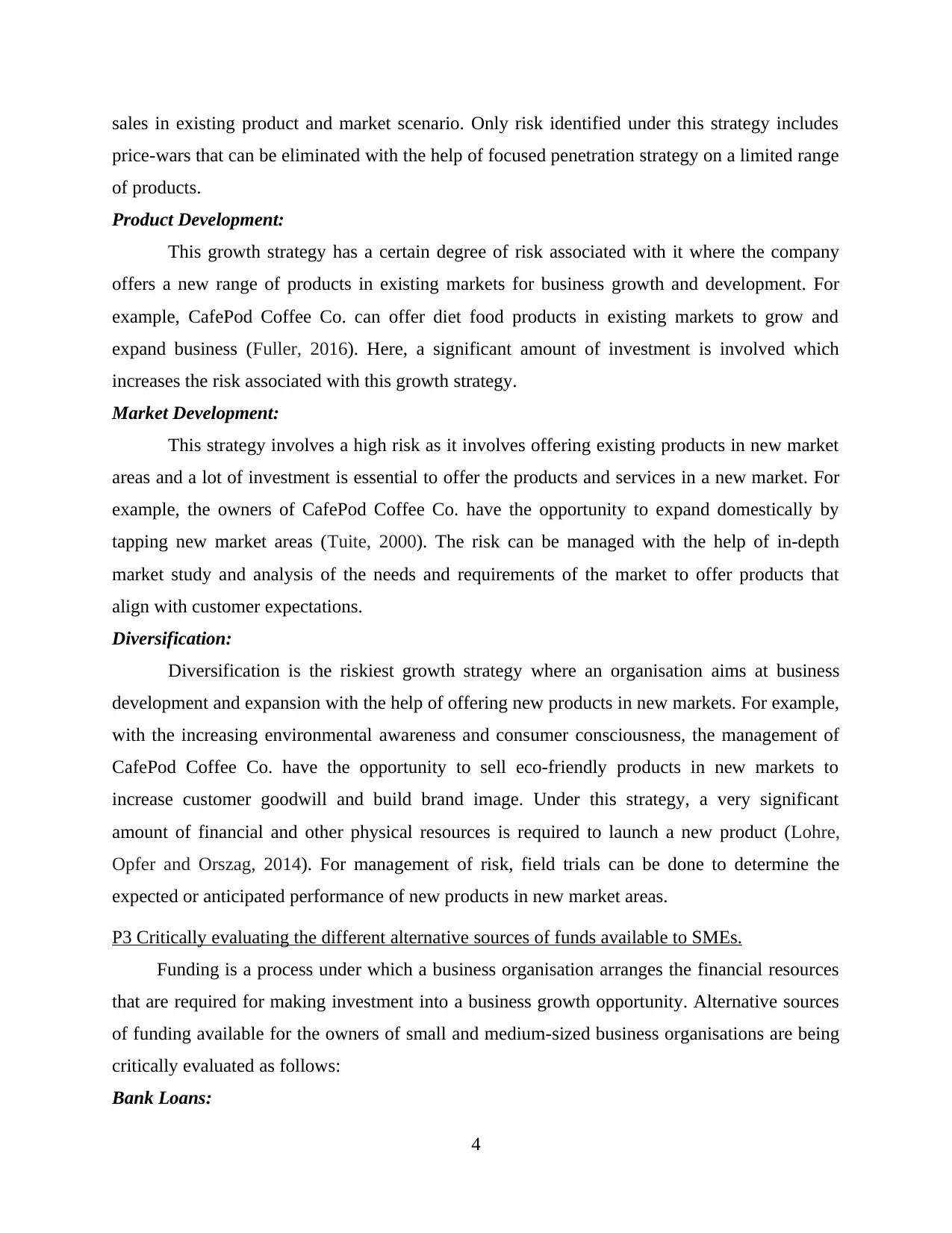
sales in existing product and market scenario. Only risk identified under this strategy includes
price-wars that can be eliminated with the help of focused penetration strategy on a limited range
of products.
Product Development:
This growth strategy has a certain degree of risk associated with it where the company
offers a new range of products in existing markets for business growth and development. For
example, CafePod Coffee Co. can offer diet food products in existing markets to grow and
expand business (Fuller, 2016). Here, a significant amount of investment is involved which
increases the risk associated with this growth strategy.
Market Development:
This strategy involves a high risk as it involves offering existing products in new market
areas and a lot of investment is essential to offer the products and services in a new market. For
example, the owners of CafePod Coffee Co. have the opportunity to expand domestically by
tapping new market areas (Tuite, 2000). The risk can be managed with the help of in-depth
market study and analysis of the needs and requirements of the market to offer products that
align with customer expectations.
Diversification:
Diversification is the riskiest growth strategy where an organisation aims at business
development and expansion with the help of offering new products in new markets. For example,
with the increasing environmental awareness and consumer consciousness, the management of
CafePod Coffee Co. have the opportunity to sell eco-friendly products in new markets to
increase customer goodwill and build brand image. Under this strategy, a very significant
amount of financial and other physical resources is required to launch a new product (Lohre,
Opfer and Orszag, 2014). For management of risk, field trials can be done to determine the
expected or anticipated performance of new products in new market areas.
P3 Critically evaluating the different alternative sources of funds available to SMEs.
Funding is a process under which a business organisation arranges the financial resources
that are required for making investment into a business growth opportunity. Alternative sources
of funding available for the owners of small and medium-sized business organisations are being
critically evaluated as follows:
Bank Loans:
4
price-wars that can be eliminated with the help of focused penetration strategy on a limited range
of products.
Product Development:
This growth strategy has a certain degree of risk associated with it where the company
offers a new range of products in existing markets for business growth and development. For
example, CafePod Coffee Co. can offer diet food products in existing markets to grow and
expand business (Fuller, 2016). Here, a significant amount of investment is involved which
increases the risk associated with this growth strategy.
Market Development:
This strategy involves a high risk as it involves offering existing products in new market
areas and a lot of investment is essential to offer the products and services in a new market. For
example, the owners of CafePod Coffee Co. have the opportunity to expand domestically by
tapping new market areas (Tuite, 2000). The risk can be managed with the help of in-depth
market study and analysis of the needs and requirements of the market to offer products that
align with customer expectations.
Diversification:
Diversification is the riskiest growth strategy where an organisation aims at business
development and expansion with the help of offering new products in new markets. For example,
with the increasing environmental awareness and consumer consciousness, the management of
CafePod Coffee Co. have the opportunity to sell eco-friendly products in new markets to
increase customer goodwill and build brand image. Under this strategy, a very significant
amount of financial and other physical resources is required to launch a new product (Lohre,
Opfer and Orszag, 2014). For management of risk, field trials can be done to determine the
expected or anticipated performance of new products in new market areas.
P3 Critically evaluating the different alternative sources of funds available to SMEs.
Funding is a process under which a business organisation arranges the financial resources
that are required for making investment into a business growth opportunity. Alternative sources
of funding available for the owners of small and medium-sized business organisations are being
critically evaluated as follows:
Bank Loans:
4
Secure Best Marks with AI Grader
Need help grading? Try our AI Grader for instant feedback on your assignments.
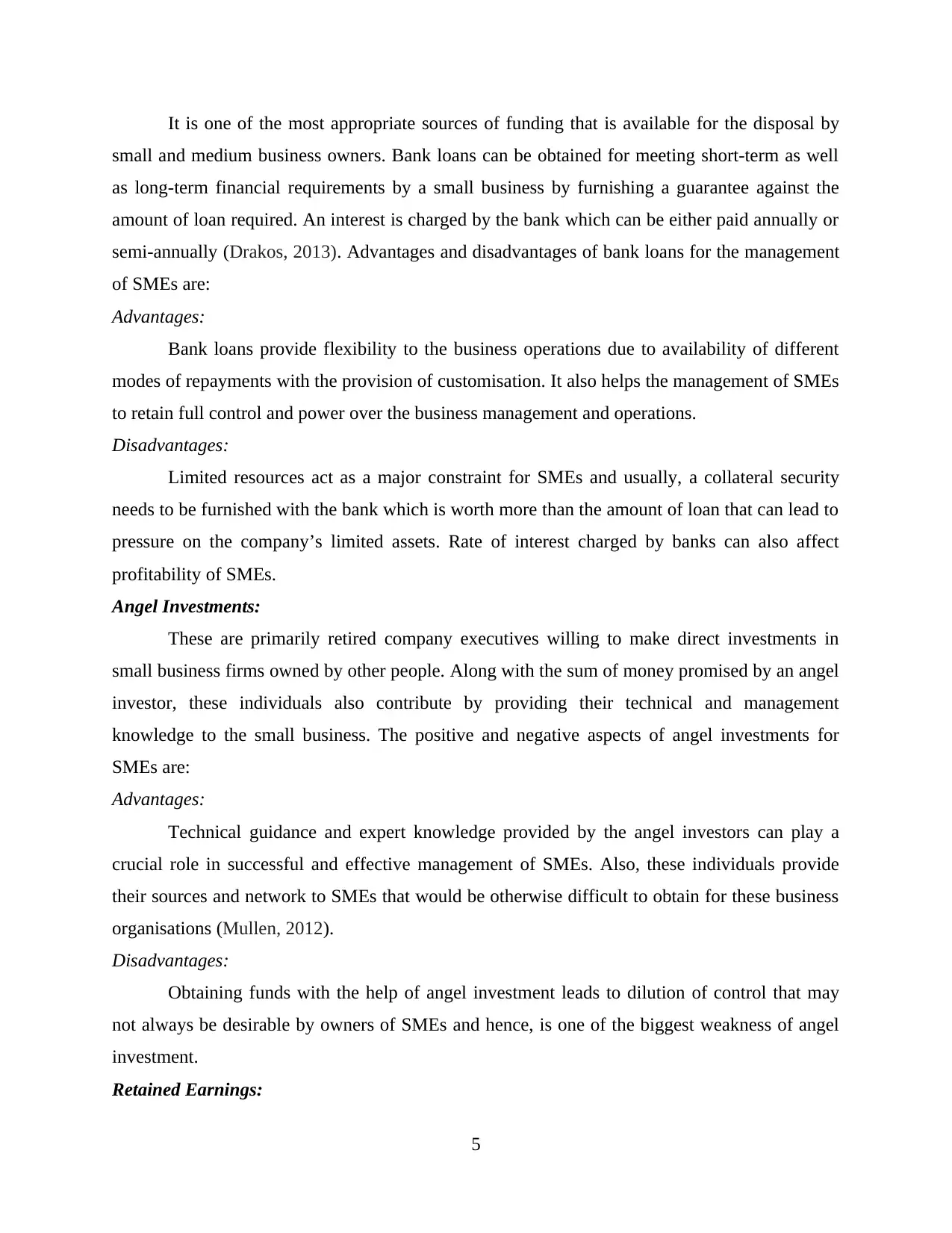
It is one of the most appropriate sources of funding that is available for the disposal by
small and medium business owners. Bank loans can be obtained for meeting short-term as well
as long-term financial requirements by a small business by furnishing a guarantee against the
amount of loan required. An interest is charged by the bank which can be either paid annually or
semi-annually (Drakos, 2013). Advantages and disadvantages of bank loans for the management
of SMEs are:
Advantages:
Bank loans provide flexibility to the business operations due to availability of different
modes of repayments with the provision of customisation. It also helps the management of SMEs
to retain full control and power over the business management and operations.
Disadvantages:
Limited resources act as a major constraint for SMEs and usually, a collateral security
needs to be furnished with the bank which is worth more than the amount of loan that can lead to
pressure on the company’s limited assets. Rate of interest charged by banks can also affect
profitability of SMEs.
Angel Investments:
These are primarily retired company executives willing to make direct investments in
small business firms owned by other people. Along with the sum of money promised by an angel
investor, these individuals also contribute by providing their technical and management
knowledge to the small business. The positive and negative aspects of angel investments for
SMEs are:
Advantages:
Technical guidance and expert knowledge provided by the angel investors can play a
crucial role in successful and effective management of SMEs. Also, these individuals provide
their sources and network to SMEs that would be otherwise difficult to obtain for these business
organisations (Mullen, 2012).
Disadvantages:
Obtaining funds with the help of angel investment leads to dilution of control that may
not always be desirable by owners of SMEs and hence, is one of the biggest weakness of angel
investment.
Retained Earnings:
5
small and medium business owners. Bank loans can be obtained for meeting short-term as well
as long-term financial requirements by a small business by furnishing a guarantee against the
amount of loan required. An interest is charged by the bank which can be either paid annually or
semi-annually (Drakos, 2013). Advantages and disadvantages of bank loans for the management
of SMEs are:
Advantages:
Bank loans provide flexibility to the business operations due to availability of different
modes of repayments with the provision of customisation. It also helps the management of SMEs
to retain full control and power over the business management and operations.
Disadvantages:
Limited resources act as a major constraint for SMEs and usually, a collateral security
needs to be furnished with the bank which is worth more than the amount of loan that can lead to
pressure on the company’s limited assets. Rate of interest charged by banks can also affect
profitability of SMEs.
Angel Investments:
These are primarily retired company executives willing to make direct investments in
small business firms owned by other people. Along with the sum of money promised by an angel
investor, these individuals also contribute by providing their technical and management
knowledge to the small business. The positive and negative aspects of angel investments for
SMEs are:
Advantages:
Technical guidance and expert knowledge provided by the angel investors can play a
crucial role in successful and effective management of SMEs. Also, these individuals provide
their sources and network to SMEs that would be otherwise difficult to obtain for these business
organisations (Mullen, 2012).
Disadvantages:
Obtaining funds with the help of angel investment leads to dilution of control that may
not always be desirable by owners of SMEs and hence, is one of the biggest weakness of angel
investment.
Retained Earnings:
5
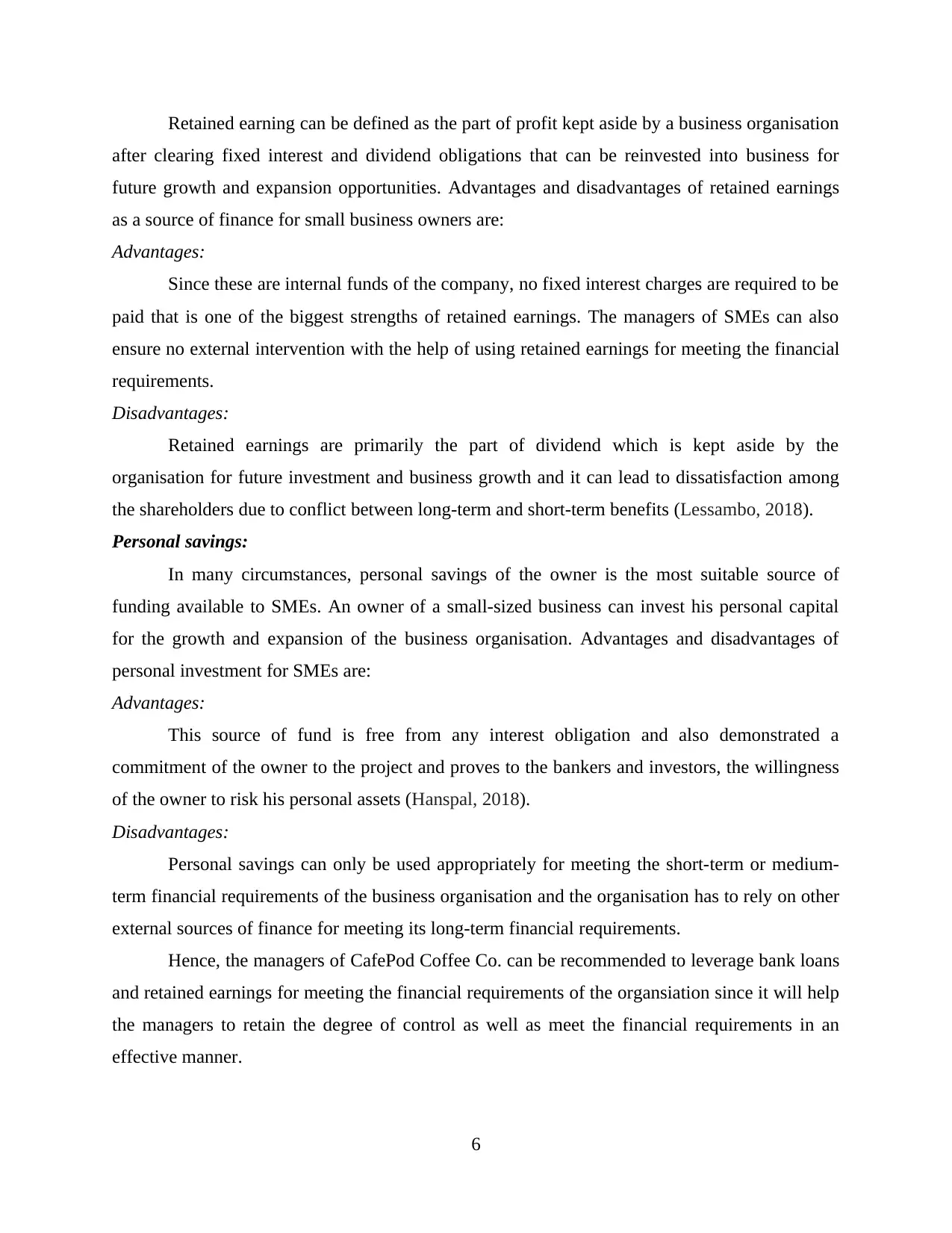
Retained earning can be defined as the part of profit kept aside by a business organisation
after clearing fixed interest and dividend obligations that can be reinvested into business for
future growth and expansion opportunities. Advantages and disadvantages of retained earnings
as a source of finance for small business owners are:
Advantages:
Since these are internal funds of the company, no fixed interest charges are required to be
paid that is one of the biggest strengths of retained earnings. The managers of SMEs can also
ensure no external intervention with the help of using retained earnings for meeting the financial
requirements.
Disadvantages:
Retained earnings are primarily the part of dividend which is kept aside by the
organisation for future investment and business growth and it can lead to dissatisfaction among
the shareholders due to conflict between long-term and short-term benefits (Lessambo, 2018).
Personal savings:
In many circumstances, personal savings of the owner is the most suitable source of
funding available to SMEs. An owner of a small-sized business can invest his personal capital
for the growth and expansion of the business organisation. Advantages and disadvantages of
personal investment for SMEs are:
Advantages:
This source of fund is free from any interest obligation and also demonstrated a
commitment of the owner to the project and proves to the bankers and investors, the willingness
of the owner to risk his personal assets (Hanspal, 2018).
Disadvantages:
Personal savings can only be used appropriately for meeting the short-term or medium-
term financial requirements of the business organisation and the organisation has to rely on other
external sources of finance for meeting its long-term financial requirements.
Hence, the managers of CafePod Coffee Co. can be recommended to leverage bank loans
and retained earnings for meeting the financial requirements of the organsiation since it will help
the managers to retain the degree of control as well as meet the financial requirements in an
effective manner.
6
after clearing fixed interest and dividend obligations that can be reinvested into business for
future growth and expansion opportunities. Advantages and disadvantages of retained earnings
as a source of finance for small business owners are:
Advantages:
Since these are internal funds of the company, no fixed interest charges are required to be
paid that is one of the biggest strengths of retained earnings. The managers of SMEs can also
ensure no external intervention with the help of using retained earnings for meeting the financial
requirements.
Disadvantages:
Retained earnings are primarily the part of dividend which is kept aside by the
organisation for future investment and business growth and it can lead to dissatisfaction among
the shareholders due to conflict between long-term and short-term benefits (Lessambo, 2018).
Personal savings:
In many circumstances, personal savings of the owner is the most suitable source of
funding available to SMEs. An owner of a small-sized business can invest his personal capital
for the growth and expansion of the business organisation. Advantages and disadvantages of
personal investment for SMEs are:
Advantages:
This source of fund is free from any interest obligation and also demonstrated a
commitment of the owner to the project and proves to the bankers and investors, the willingness
of the owner to risk his personal assets (Hanspal, 2018).
Disadvantages:
Personal savings can only be used appropriately for meeting the short-term or medium-
term financial requirements of the business organisation and the organisation has to rely on other
external sources of finance for meeting its long-term financial requirements.
Hence, the managers of CafePod Coffee Co. can be recommended to leverage bank loans
and retained earnings for meeting the financial requirements of the organsiation since it will help
the managers to retain the degree of control as well as meet the financial requirements in an
effective manner.
6

TASK 2
P4 Business plan.
A business plan is a document which contains information with respect to organisational
goals and objectives, manner in which goals are to be attained and the time limit within which
goals should be achieved (Haag, 2013).
SMART Analysis is a framework which is used in establishment of business goals and
objectives within the parameters of Specific; clearly outlining the task and requirements,
Measurable; ability to monitor progress, Achievable; attainable by efforts, Realistic; within the
scope of resources and abilities of the organisation and Timely; within a specific timeframe
(Toffler, 2016).
Business plan for CafePod Coffee Co.
1. Executive Summary:
Growth of an organisation depends on the factors in the external environment and the
strengths and the capabilities of an organisation to identify opportunities and threats. In the
following business plan, organisation vision and mission of CafePod Coffee Co. is being
considered and determination of the extent of gap that exists between customer expectations and
the current products and services being offered by the company is being done to identify any
opportunities for growth and business development. The plan provides recommendation on
strategies and the manner in which these strategies should be implemented for maximisation of
revenue and future growth opportunities.
2. Company Summary:
CafePod Coffee Co. is an independent company which was founded in the year 2011 and
the headquarters of the company are located at Portsmouth, England. The company is an
innovative manufacturer of coffee capsules and the vision of the company is to change the face
of Coffee in United Kingdom and Europe (Cafepod Coffee, 2020).
3. Products:
A wide range of coffee products in different categories are offered by the company such
as intense, smooth, arabica lungo, decaf, hot or cold blending espresso etcetera. The company
also manufactures coffee capsules that act as espresso blends to revolutionize the coffee industry
and consumer behaviour in United Kingdom.
4. Market Analysis:
7
P4 Business plan.
A business plan is a document which contains information with respect to organisational
goals and objectives, manner in which goals are to be attained and the time limit within which
goals should be achieved (Haag, 2013).
SMART Analysis is a framework which is used in establishment of business goals and
objectives within the parameters of Specific; clearly outlining the task and requirements,
Measurable; ability to monitor progress, Achievable; attainable by efforts, Realistic; within the
scope of resources and abilities of the organisation and Timely; within a specific timeframe
(Toffler, 2016).
Business plan for CafePod Coffee Co.
1. Executive Summary:
Growth of an organisation depends on the factors in the external environment and the
strengths and the capabilities of an organisation to identify opportunities and threats. In the
following business plan, organisation vision and mission of CafePod Coffee Co. is being
considered and determination of the extent of gap that exists between customer expectations and
the current products and services being offered by the company is being done to identify any
opportunities for growth and business development. The plan provides recommendation on
strategies and the manner in which these strategies should be implemented for maximisation of
revenue and future growth opportunities.
2. Company Summary:
CafePod Coffee Co. is an independent company which was founded in the year 2011 and
the headquarters of the company are located at Portsmouth, England. The company is an
innovative manufacturer of coffee capsules and the vision of the company is to change the face
of Coffee in United Kingdom and Europe (Cafepod Coffee, 2020).
3. Products:
A wide range of coffee products in different categories are offered by the company such
as intense, smooth, arabica lungo, decaf, hot or cold blending espresso etcetera. The company
also manufactures coffee capsules that act as espresso blends to revolutionize the coffee industry
and consumer behaviour in United Kingdom.
4. Market Analysis:
7
Paraphrase This Document
Need a fresh take? Get an instant paraphrase of this document with our AI Paraphraser
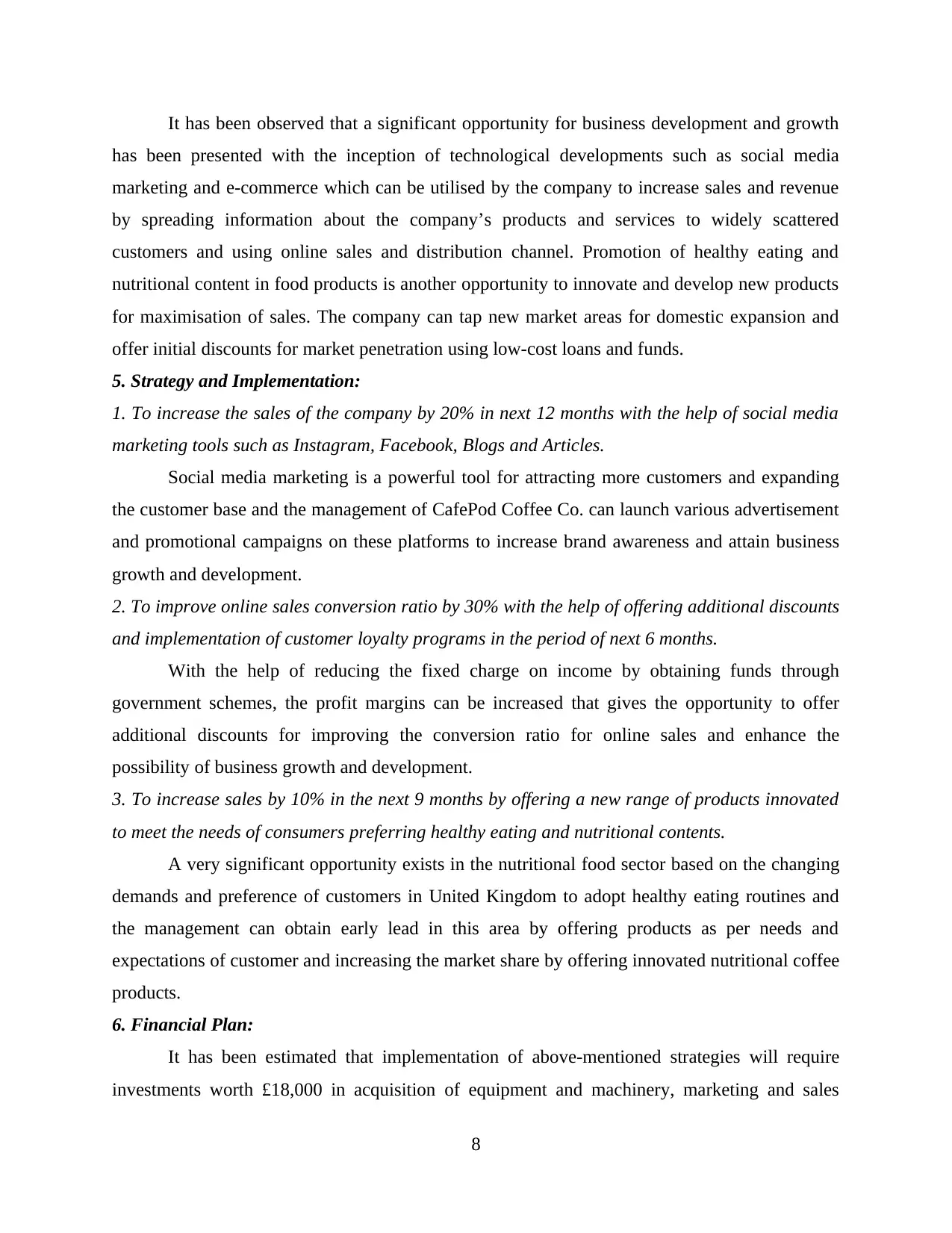
It has been observed that a significant opportunity for business development and growth
has been presented with the inception of technological developments such as social media
marketing and e-commerce which can be utilised by the company to increase sales and revenue
by spreading information about the company’s products and services to widely scattered
customers and using online sales and distribution channel. Promotion of healthy eating and
nutritional content in food products is another opportunity to innovate and develop new products
for maximisation of sales. The company can tap new market areas for domestic expansion and
offer initial discounts for market penetration using low-cost loans and funds.
5. Strategy and Implementation:
1. To increase the sales of the company by 20% in next 12 months with the help of social media
marketing tools such as Instagram, Facebook, Blogs and Articles.
Social media marketing is a powerful tool for attracting more customers and expanding
the customer base and the management of CafePod Coffee Co. can launch various advertisement
and promotional campaigns on these platforms to increase brand awareness and attain business
growth and development.
2. To improve online sales conversion ratio by 30% with the help of offering additional discounts
and implementation of customer loyalty programs in the period of next 6 months.
With the help of reducing the fixed charge on income by obtaining funds through
government schemes, the profit margins can be increased that gives the opportunity to offer
additional discounts for improving the conversion ratio for online sales and enhance the
possibility of business growth and development.
3. To increase sales by 10% in the next 9 months by offering a new range of products innovated
to meet the needs of consumers preferring healthy eating and nutritional contents.
A very significant opportunity exists in the nutritional food sector based on the changing
demands and preference of customers in United Kingdom to adopt healthy eating routines and
the management can obtain early lead in this area by offering products as per needs and
expectations of customer and increasing the market share by offering innovated nutritional coffee
products.
6. Financial Plan:
It has been estimated that implementation of above-mentioned strategies will require
investments worth £18,000 in acquisition of equipment and machinery, marketing and sales
8
has been presented with the inception of technological developments such as social media
marketing and e-commerce which can be utilised by the company to increase sales and revenue
by spreading information about the company’s products and services to widely scattered
customers and using online sales and distribution channel. Promotion of healthy eating and
nutritional content in food products is another opportunity to innovate and develop new products
for maximisation of sales. The company can tap new market areas for domestic expansion and
offer initial discounts for market penetration using low-cost loans and funds.
5. Strategy and Implementation:
1. To increase the sales of the company by 20% in next 12 months with the help of social media
marketing tools such as Instagram, Facebook, Blogs and Articles.
Social media marketing is a powerful tool for attracting more customers and expanding
the customer base and the management of CafePod Coffee Co. can launch various advertisement
and promotional campaigns on these platforms to increase brand awareness and attain business
growth and development.
2. To improve online sales conversion ratio by 30% with the help of offering additional discounts
and implementation of customer loyalty programs in the period of next 6 months.
With the help of reducing the fixed charge on income by obtaining funds through
government schemes, the profit margins can be increased that gives the opportunity to offer
additional discounts for improving the conversion ratio for online sales and enhance the
possibility of business growth and development.
3. To increase sales by 10% in the next 9 months by offering a new range of products innovated
to meet the needs of consumers preferring healthy eating and nutritional contents.
A very significant opportunity exists in the nutritional food sector based on the changing
demands and preference of customers in United Kingdom to adopt healthy eating routines and
the management can obtain early lead in this area by offering products as per needs and
expectations of customer and increasing the market share by offering innovated nutritional coffee
products.
6. Financial Plan:
It has been estimated that implementation of above-mentioned strategies will require
investments worth £18,000 in acquisition of equipment and machinery, marketing and sales
8
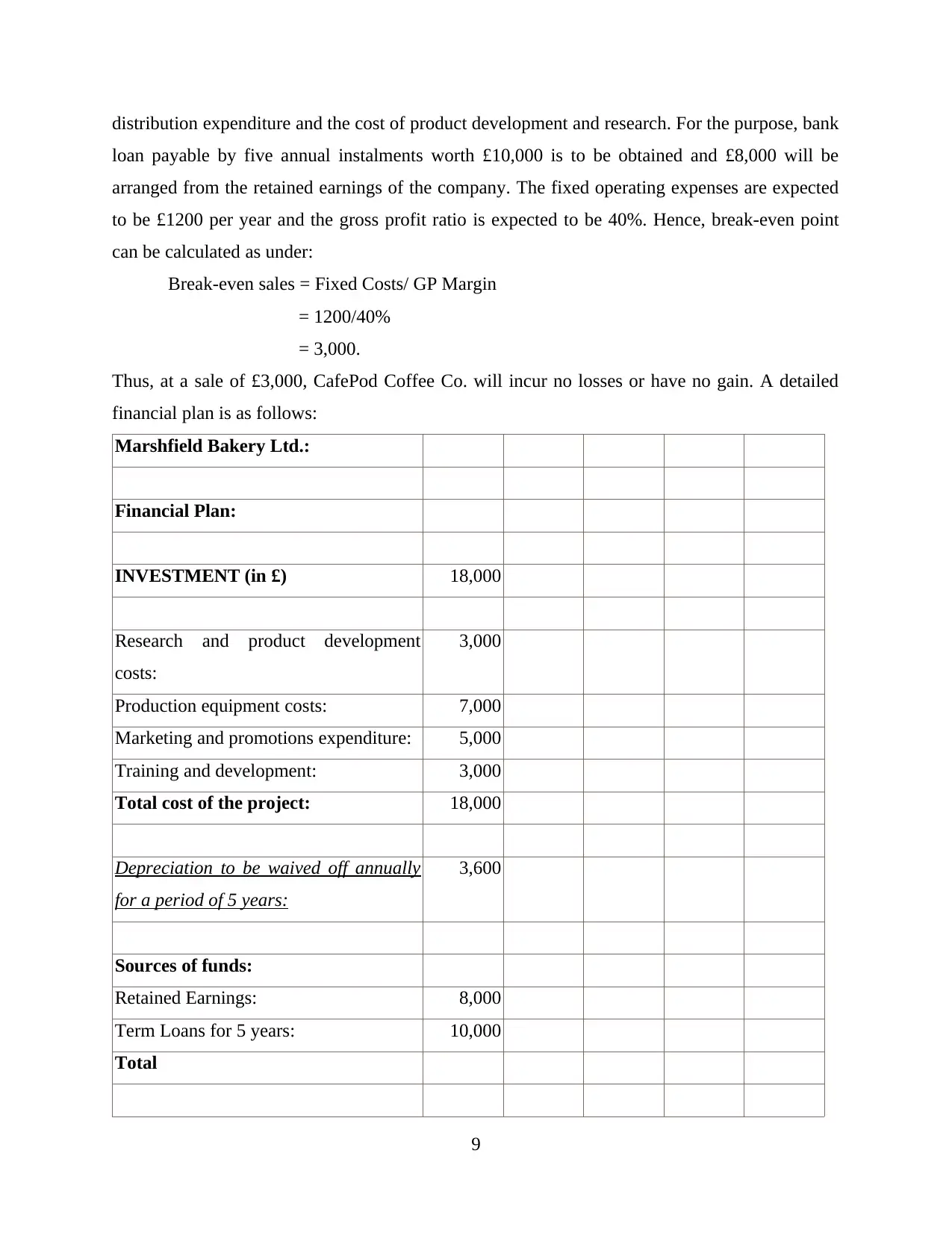
distribution expenditure and the cost of product development and research. For the purpose, bank
loan payable by five annual instalments worth £10,000 is to be obtained and £8,000 will be
arranged from the retained earnings of the company. The fixed operating expenses are expected
to be £1200 per year and the gross profit ratio is expected to be 40%. Hence, break-even point
can be calculated as under:
Break-even sales = Fixed Costs/ GP Margin
= 1200/40%
= 3,000.
Thus, at a sale of £3,000, CafePod Coffee Co. will incur no losses or have no gain. A detailed
financial plan is as follows:
Marshfield Bakery Ltd.:
Financial Plan:
INVESTMENT (in £) 18,000
Research and product development
costs:
3,000
Production equipment costs: 7,000
Marketing and promotions expenditure: 5,000
Training and development: 3,000
Total cost of the project: 18,000
Depreciation to be waived off annually
for a period of 5 years:
3,600
Sources of funds:
Retained Earnings: 8,000
Term Loans for 5 years: 10,000
Total
9
loan payable by five annual instalments worth £10,000 is to be obtained and £8,000 will be
arranged from the retained earnings of the company. The fixed operating expenses are expected
to be £1200 per year and the gross profit ratio is expected to be 40%. Hence, break-even point
can be calculated as under:
Break-even sales = Fixed Costs/ GP Margin
= 1200/40%
= 3,000.
Thus, at a sale of £3,000, CafePod Coffee Co. will incur no losses or have no gain. A detailed
financial plan is as follows:
Marshfield Bakery Ltd.:
Financial Plan:
INVESTMENT (in £) 18,000
Research and product development
costs:
3,000
Production equipment costs: 7,000
Marketing and promotions expenditure: 5,000
Training and development: 3,000
Total cost of the project: 18,000
Depreciation to be waived off annually
for a period of 5 years:
3,600
Sources of funds:
Retained Earnings: 8,000
Term Loans for 5 years: 10,000
Total
9
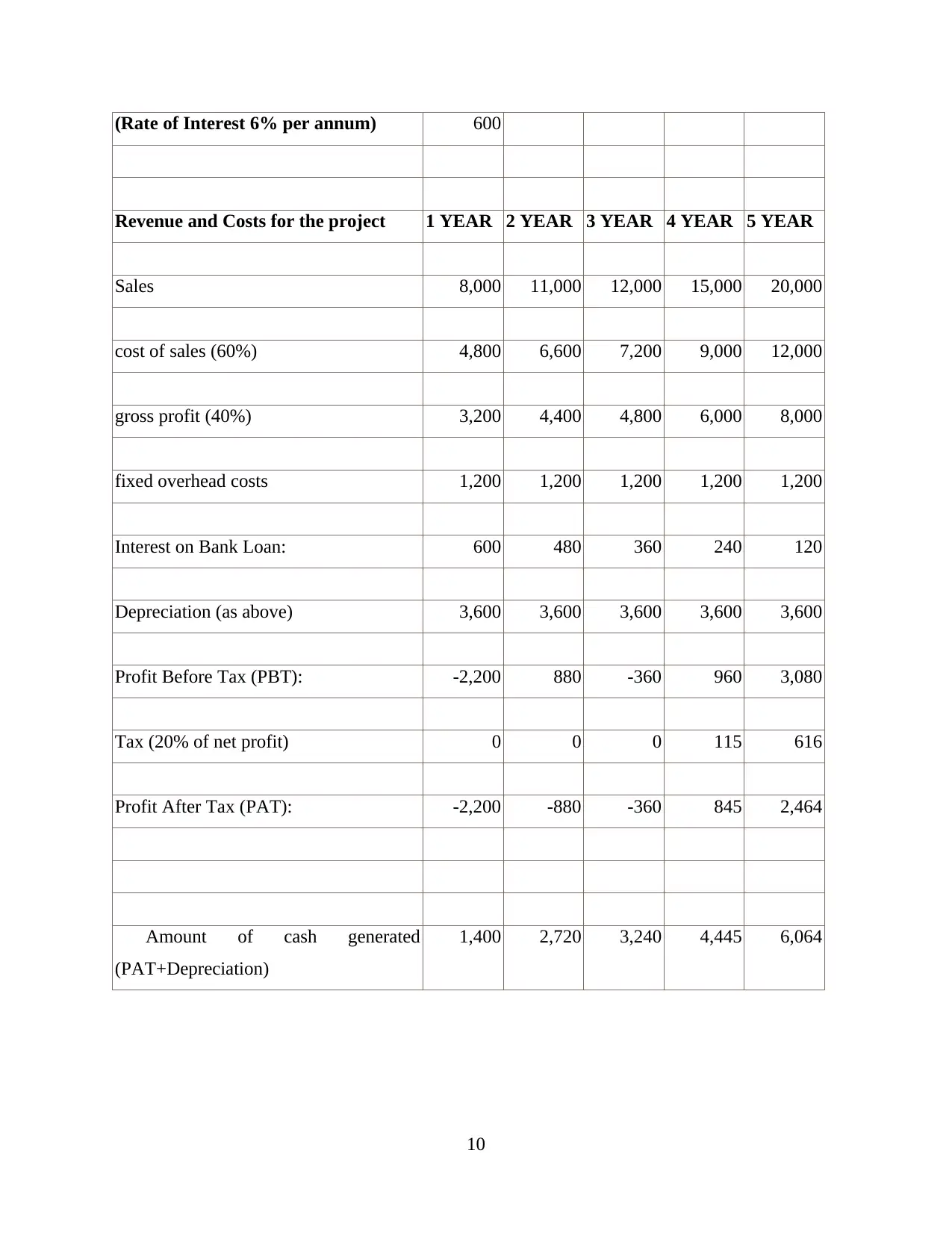
(Rate of Interest 6% per annum) 600
Revenue and Costs for the project 1 YEAR 2 YEAR 3 YEAR 4 YEAR 5 YEAR
Sales 8,000 11,000 12,000 15,000 20,000
cost of sales (60%) 4,800 6,600 7,200 9,000 12,000
gross profit (40%) 3,200 4,400 4,800 6,000 8,000
fixed overhead costs 1,200 1,200 1,200 1,200 1,200
Interest on Bank Loan: 600 480 360 240 120
Depreciation (as above) 3,600 3,600 3,600 3,600 3,600
Profit Before Tax (PBT): -2,200 880 -360 960 3,080
Tax (20% of net profit) 0 0 0 115 616
Profit After Tax (PAT): -2,200 -880 -360 845 2,464
Amount of cash generated
(PAT+Depreciation)
1,400 2,720 3,240 4,445 6,064
10
Revenue and Costs for the project 1 YEAR 2 YEAR 3 YEAR 4 YEAR 5 YEAR
Sales 8,000 11,000 12,000 15,000 20,000
cost of sales (60%) 4,800 6,600 7,200 9,000 12,000
gross profit (40%) 3,200 4,400 4,800 6,000 8,000
fixed overhead costs 1,200 1,200 1,200 1,200 1,200
Interest on Bank Loan: 600 480 360 240 120
Depreciation (as above) 3,600 3,600 3,600 3,600 3,600
Profit Before Tax (PBT): -2,200 880 -360 960 3,080
Tax (20% of net profit) 0 0 0 115 616
Profit After Tax (PAT): -2,200 -880 -360 845 2,464
Amount of cash generated
(PAT+Depreciation)
1,400 2,720 3,240 4,445 6,064
10
Secure Best Marks with AI Grader
Need help grading? Try our AI Grader for instant feedback on your assignments.
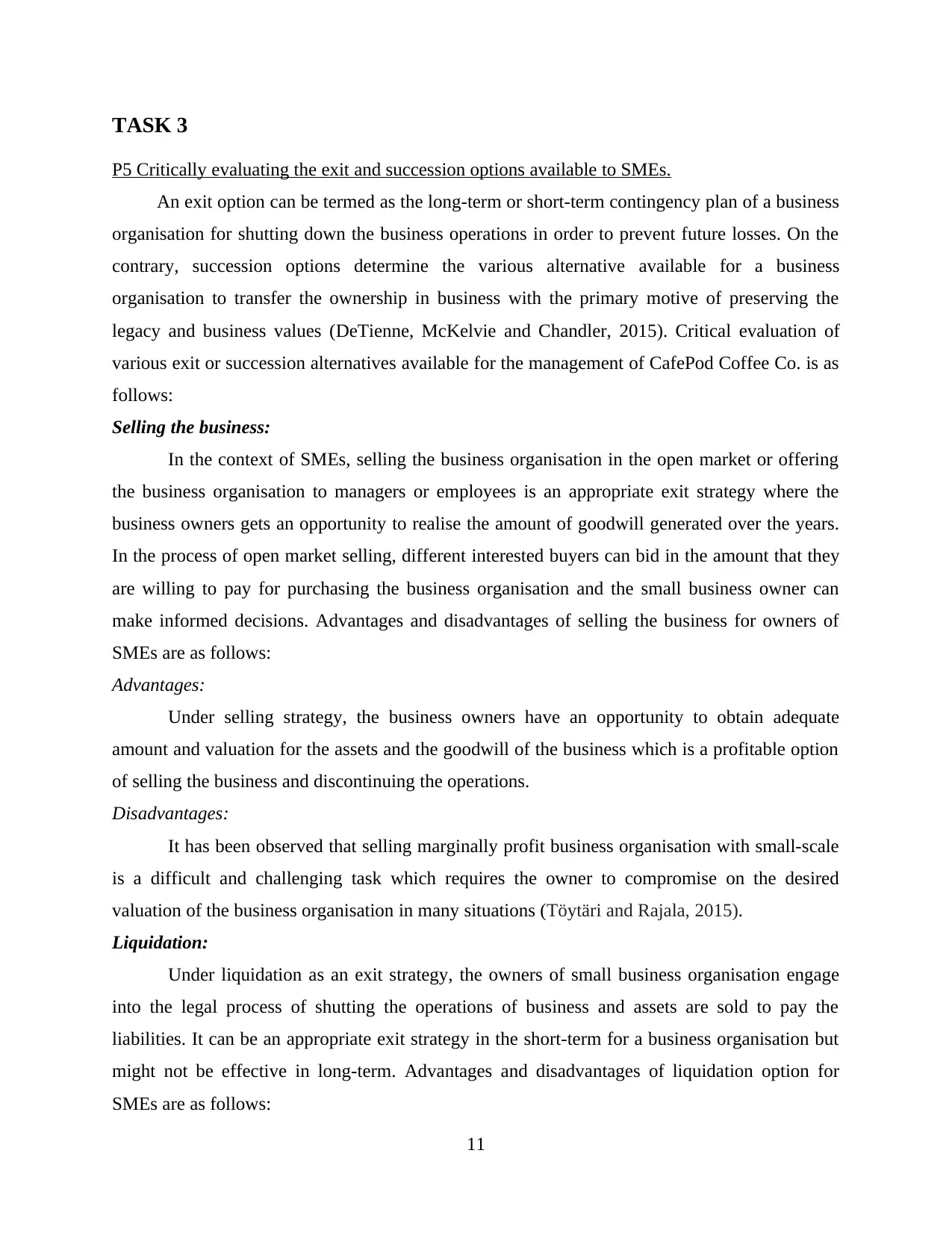
TASK 3
P5 Critically evaluating the exit and succession options available to SMEs.
An exit option can be termed as the long-term or short-term contingency plan of a business
organisation for shutting down the business operations in order to prevent future losses. On the
contrary, succession options determine the various alternative available for a business
organisation to transfer the ownership in business with the primary motive of preserving the
legacy and business values (DeTienne, McKelvie and Chandler, 2015). Critical evaluation of
various exit or succession alternatives available for the management of CafePod Coffee Co. is as
follows:
Selling the business:
In the context of SMEs, selling the business organisation in the open market or offering
the business organisation to managers or employees is an appropriate exit strategy where the
business owners gets an opportunity to realise the amount of goodwill generated over the years.
In the process of open market selling, different interested buyers can bid in the amount that they
are willing to pay for purchasing the business organisation and the small business owner can
make informed decisions. Advantages and disadvantages of selling the business for owners of
SMEs are as follows:
Advantages:
Under selling strategy, the business owners have an opportunity to obtain adequate
amount and valuation for the assets and the goodwill of the business which is a profitable option
of selling the business and discontinuing the operations.
Disadvantages:
It has been observed that selling marginally profit business organisation with small-scale
is a difficult and challenging task which requires the owner to compromise on the desired
valuation of the business organisation in many situations (Töytäri and Rajala, 2015).
Liquidation:
Under liquidation as an exit strategy, the owners of small business organisation engage
into the legal process of shutting the operations of business and assets are sold to pay the
liabilities. It can be an appropriate exit strategy in the short-term for a business organisation but
might not be effective in long-term. Advantages and disadvantages of liquidation option for
SMEs are as follows:
11
P5 Critically evaluating the exit and succession options available to SMEs.
An exit option can be termed as the long-term or short-term contingency plan of a business
organisation for shutting down the business operations in order to prevent future losses. On the
contrary, succession options determine the various alternative available for a business
organisation to transfer the ownership in business with the primary motive of preserving the
legacy and business values (DeTienne, McKelvie and Chandler, 2015). Critical evaluation of
various exit or succession alternatives available for the management of CafePod Coffee Co. is as
follows:
Selling the business:
In the context of SMEs, selling the business organisation in the open market or offering
the business organisation to managers or employees is an appropriate exit strategy where the
business owners gets an opportunity to realise the amount of goodwill generated over the years.
In the process of open market selling, different interested buyers can bid in the amount that they
are willing to pay for purchasing the business organisation and the small business owner can
make informed decisions. Advantages and disadvantages of selling the business for owners of
SMEs are as follows:
Advantages:
Under selling strategy, the business owners have an opportunity to obtain adequate
amount and valuation for the assets and the goodwill of the business which is a profitable option
of selling the business and discontinuing the operations.
Disadvantages:
It has been observed that selling marginally profit business organisation with small-scale
is a difficult and challenging task which requires the owner to compromise on the desired
valuation of the business organisation in many situations (Töytäri and Rajala, 2015).
Liquidation:
Under liquidation as an exit strategy, the owners of small business organisation engage
into the legal process of shutting the operations of business and assets are sold to pay the
liabilities. It can be an appropriate exit strategy in the short-term for a business organisation but
might not be effective in long-term. Advantages and disadvantages of liquidation option for
SMEs are as follows:
11
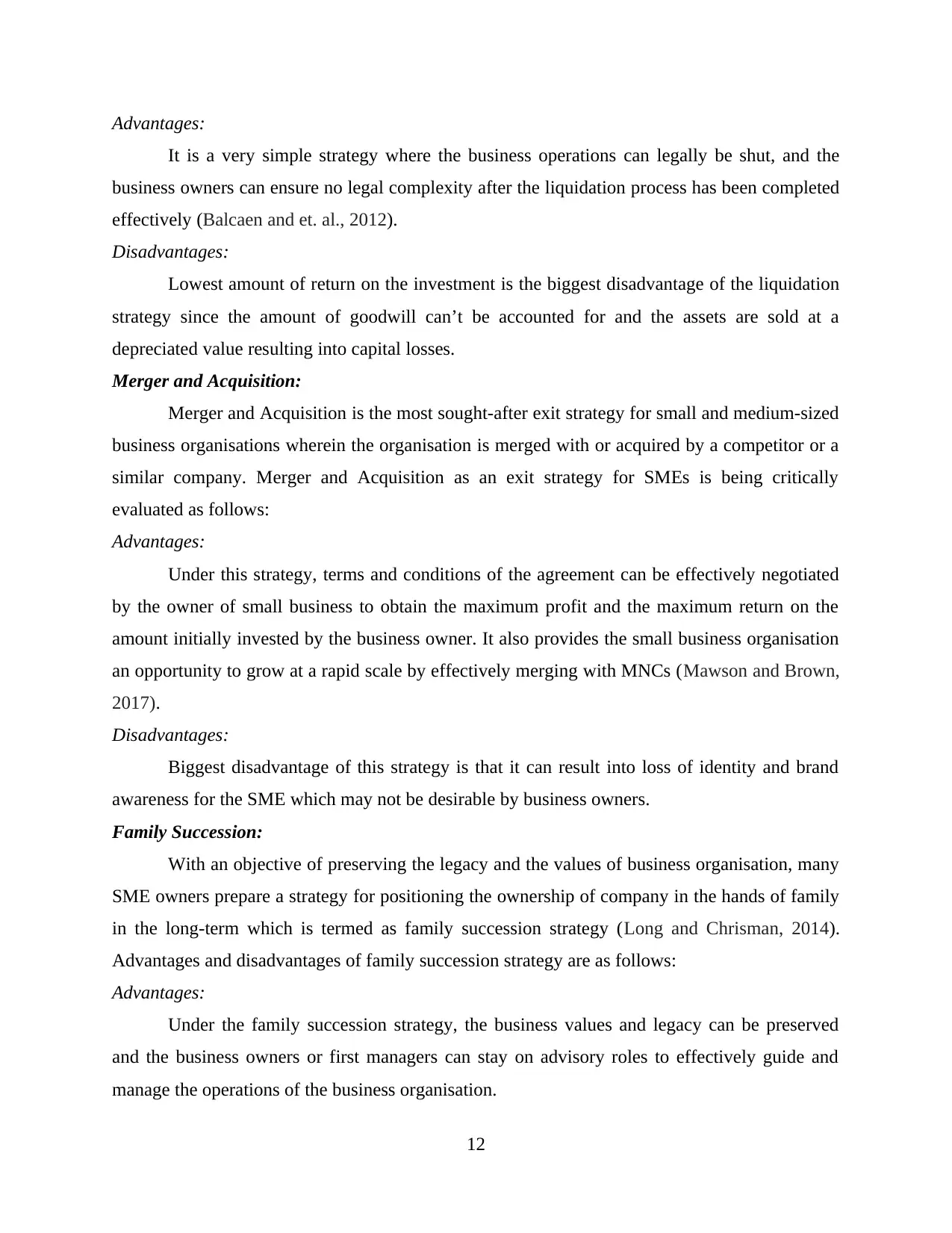
Advantages:
It is a very simple strategy where the business operations can legally be shut, and the
business owners can ensure no legal complexity after the liquidation process has been completed
effectively (Balcaen and et. al., 2012).
Disadvantages:
Lowest amount of return on the investment is the biggest disadvantage of the liquidation
strategy since the amount of goodwill can’t be accounted for and the assets are sold at a
depreciated value resulting into capital losses.
Merger and Acquisition:
Merger and Acquisition is the most sought-after exit strategy for small and medium-sized
business organisations wherein the organisation is merged with or acquired by a competitor or a
similar company. Merger and Acquisition as an exit strategy for SMEs is being critically
evaluated as follows:
Advantages:
Under this strategy, terms and conditions of the agreement can be effectively negotiated
by the owner of small business to obtain the maximum profit and the maximum return on the
amount initially invested by the business owner. It also provides the small business organisation
an opportunity to grow at a rapid scale by effectively merging with MNCs (Mawson and Brown,
2017).
Disadvantages:
Biggest disadvantage of this strategy is that it can result into loss of identity and brand
awareness for the SME which may not be desirable by business owners.
Family Succession:
With an objective of preserving the legacy and the values of business organisation, many
SME owners prepare a strategy for positioning the ownership of company in the hands of family
in the long-term which is termed as family succession strategy (Long and Chrisman, 2014).
Advantages and disadvantages of family succession strategy are as follows:
Advantages:
Under the family succession strategy, the business values and legacy can be preserved
and the business owners or first managers can stay on advisory roles to effectively guide and
manage the operations of the business organisation.
12
It is a very simple strategy where the business operations can legally be shut, and the
business owners can ensure no legal complexity after the liquidation process has been completed
effectively (Balcaen and et. al., 2012).
Disadvantages:
Lowest amount of return on the investment is the biggest disadvantage of the liquidation
strategy since the amount of goodwill can’t be accounted for and the assets are sold at a
depreciated value resulting into capital losses.
Merger and Acquisition:
Merger and Acquisition is the most sought-after exit strategy for small and medium-sized
business organisations wherein the organisation is merged with or acquired by a competitor or a
similar company. Merger and Acquisition as an exit strategy for SMEs is being critically
evaluated as follows:
Advantages:
Under this strategy, terms and conditions of the agreement can be effectively negotiated
by the owner of small business to obtain the maximum profit and the maximum return on the
amount initially invested by the business owner. It also provides the small business organisation
an opportunity to grow at a rapid scale by effectively merging with MNCs (Mawson and Brown,
2017).
Disadvantages:
Biggest disadvantage of this strategy is that it can result into loss of identity and brand
awareness for the SME which may not be desirable by business owners.
Family Succession:
With an objective of preserving the legacy and the values of business organisation, many
SME owners prepare a strategy for positioning the ownership of company in the hands of family
in the long-term which is termed as family succession strategy (Long and Chrisman, 2014).
Advantages and disadvantages of family succession strategy are as follows:
Advantages:
Under the family succession strategy, the business values and legacy can be preserved
and the business owners or first managers can stay on advisory roles to effectively guide and
manage the operations of the business organisation.
12
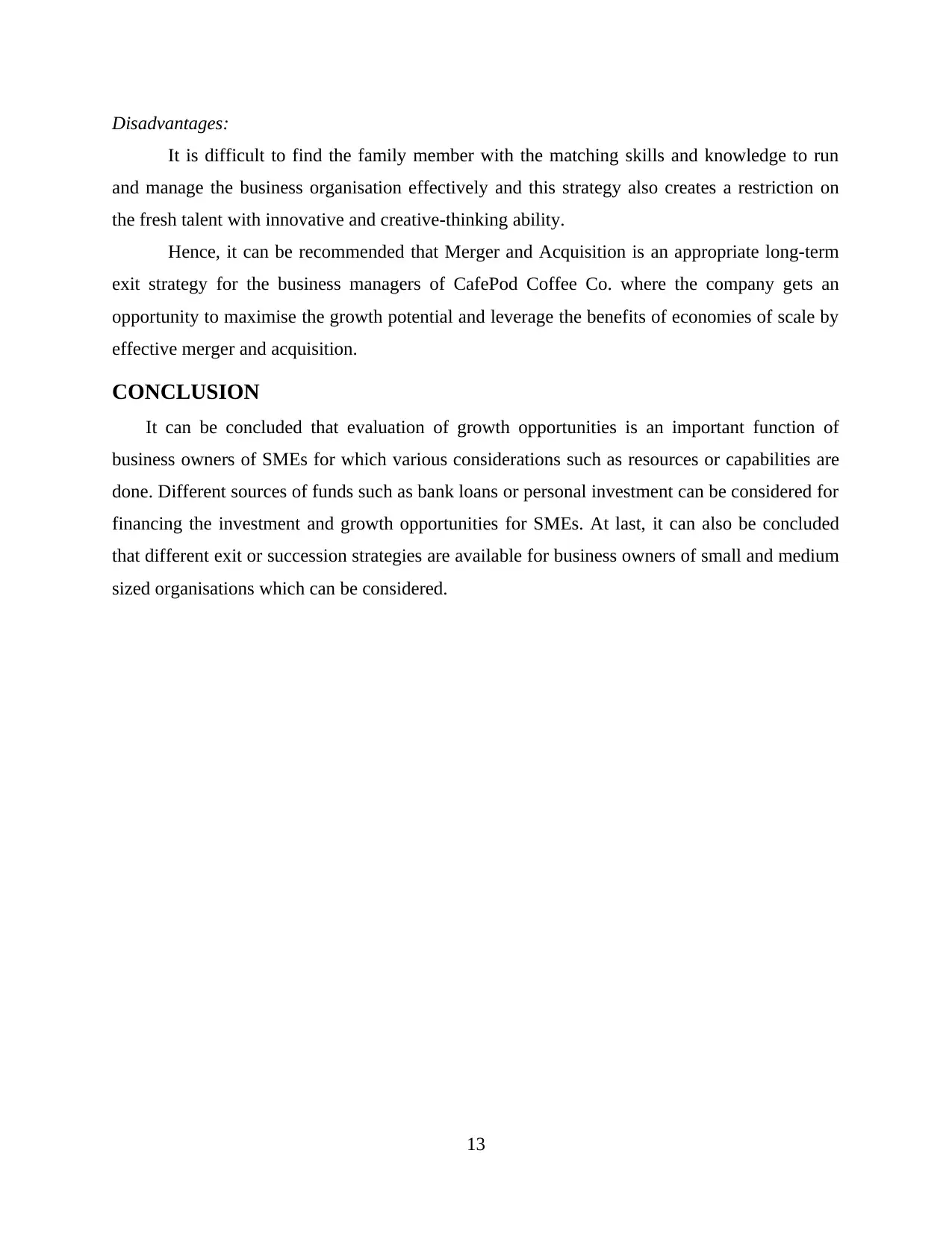
Disadvantages:
It is difficult to find the family member with the matching skills and knowledge to run
and manage the business organisation effectively and this strategy also creates a restriction on
the fresh talent with innovative and creative-thinking ability.
Hence, it can be recommended that Merger and Acquisition is an appropriate long-term
exit strategy for the business managers of CafePod Coffee Co. where the company gets an
opportunity to maximise the growth potential and leverage the benefits of economies of scale by
effective merger and acquisition.
CONCLUSION
It can be concluded that evaluation of growth opportunities is an important function of
business owners of SMEs for which various considerations such as resources or capabilities are
done. Different sources of funds such as bank loans or personal investment can be considered for
financing the investment and growth opportunities for SMEs. At last, it can also be concluded
that different exit or succession strategies are available for business owners of small and medium
sized organisations which can be considered.
13
It is difficult to find the family member with the matching skills and knowledge to run
and manage the business organisation effectively and this strategy also creates a restriction on
the fresh talent with innovative and creative-thinking ability.
Hence, it can be recommended that Merger and Acquisition is an appropriate long-term
exit strategy for the business managers of CafePod Coffee Co. where the company gets an
opportunity to maximise the growth potential and leverage the benefits of economies of scale by
effective merger and acquisition.
CONCLUSION
It can be concluded that evaluation of growth opportunities is an important function of
business owners of SMEs for which various considerations such as resources or capabilities are
done. Different sources of funds such as bank loans or personal investment can be considered for
financing the investment and growth opportunities for SMEs. At last, it can also be concluded
that different exit or succession strategies are available for business owners of small and medium
sized organisations which can be considered.
13
Paraphrase This Document
Need a fresh take? Get an instant paraphrase of this document with our AI Paraphraser
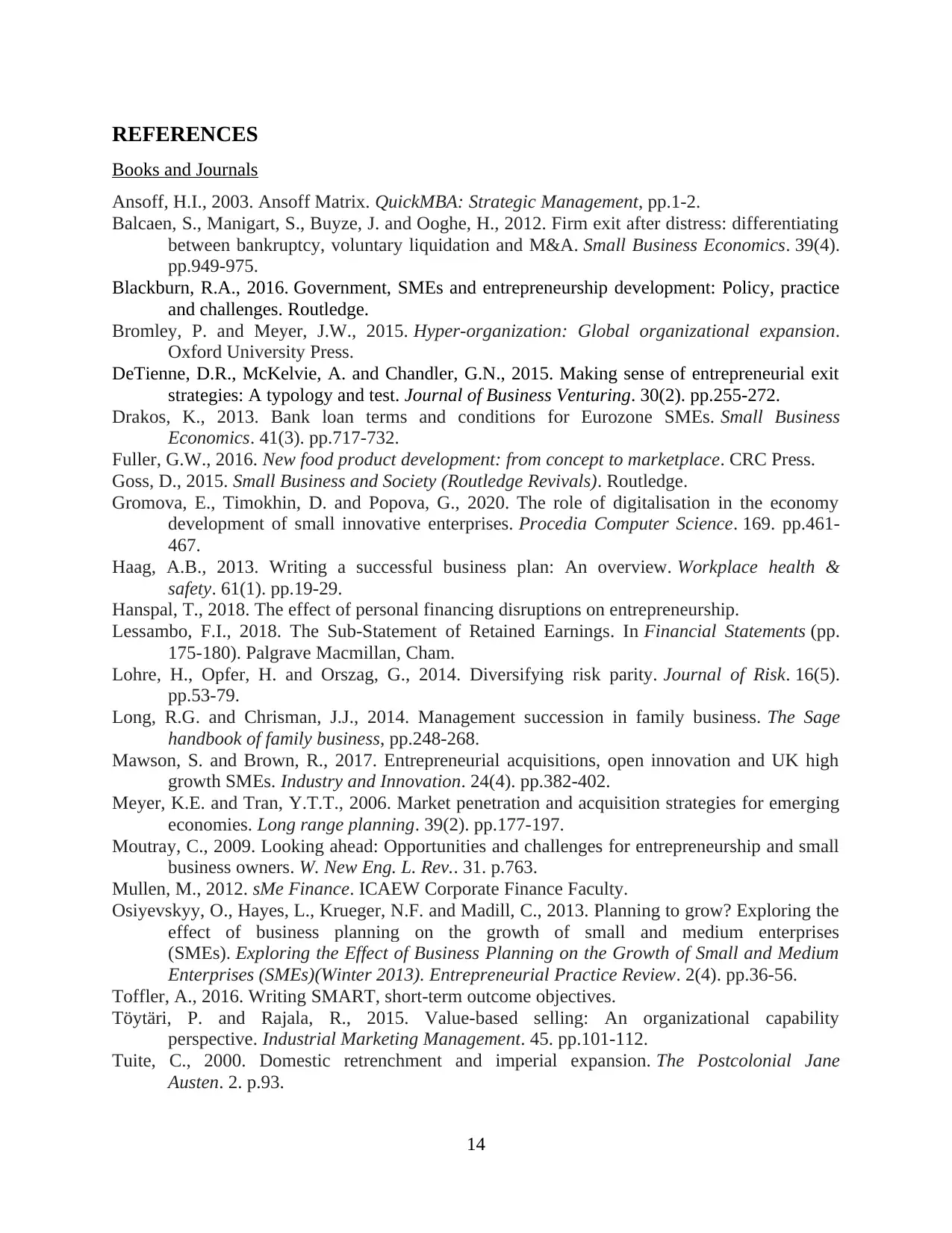
REFERENCES
Books and Journals
Ansoff, H.I., 2003. Ansoff Matrix. QuickMBA: Strategic Management, pp.1-2.
Balcaen, S., Manigart, S., Buyze, J. and Ooghe, H., 2012. Firm exit after distress: differentiating
between bankruptcy, voluntary liquidation and M&A. Small Business Economics. 39(4).
pp.949-975.
Blackburn, R.A., 2016. Government, SMEs and entrepreneurship development: Policy, practice
and challenges. Routledge.
Bromley, P. and Meyer, J.W., 2015. Hyper-organization: Global organizational expansion.
Oxford University Press.
DeTienne, D.R., McKelvie, A. and Chandler, G.N., 2015. Making sense of entrepreneurial exit
strategies: A typology and test. Journal of Business Venturing. 30(2). pp.255-272.
Drakos, K., 2013. Bank loan terms and conditions for Eurozone SMEs. Small Business
Economics. 41(3). pp.717-732.
Fuller, G.W., 2016. New food product development: from concept to marketplace. CRC Press.
Goss, D., 2015. Small Business and Society (Routledge Revivals). Routledge.
Gromova, E., Timokhin, D. and Popova, G., 2020. The role of digitalisation in the economy
development of small innovative enterprises. Procedia Computer Science. 169. pp.461-
467.
Haag, A.B., 2013. Writing a successful business plan: An overview. Workplace health &
safety. 61(1). pp.19-29.
Hanspal, T., 2018. The effect of personal financing disruptions on entrepreneurship.
Lessambo, F.I., 2018. The Sub-Statement of Retained Earnings. In Financial Statements (pp.
175-180). Palgrave Macmillan, Cham.
Lohre, H., Opfer, H. and Orszag, G., 2014. Diversifying risk parity. Journal of Risk. 16(5).
pp.53-79.
Long, R.G. and Chrisman, J.J., 2014. Management succession in family business. The Sage
handbook of family business, pp.248-268.
Mawson, S. and Brown, R., 2017. Entrepreneurial acquisitions, open innovation and UK high
growth SMEs. Industry and Innovation. 24(4). pp.382-402.
Meyer, K.E. and Tran, Y.T.T., 2006. Market penetration and acquisition strategies for emerging
economies. Long range planning. 39(2). pp.177-197.
Moutray, C., 2009. Looking ahead: Opportunities and challenges for entrepreneurship and small
business owners. W. New Eng. L. Rev.. 31. p.763.
Mullen, M., 2012. sMe Finance. ICAEW Corporate Finance Faculty.
Osiyevskyy, O., Hayes, L., Krueger, N.F. and Madill, C., 2013. Planning to grow? Exploring the
effect of business planning on the growth of small and medium enterprises
(SMEs). Exploring the Effect of Business Planning on the Growth of Small and Medium
Enterprises (SMEs)(Winter 2013). Entrepreneurial Practice Review. 2(4). pp.36-56.
Toffler, A., 2016. Writing SMART, short-term outcome objectives.
Töytäri, P. and Rajala, R., 2015. Value-based selling: An organizational capability
perspective. Industrial Marketing Management. 45. pp.101-112.
Tuite, C., 2000. Domestic retrenchment and imperial expansion. The Postcolonial Jane
Austen. 2. p.93.
14
Books and Journals
Ansoff, H.I., 2003. Ansoff Matrix. QuickMBA: Strategic Management, pp.1-2.
Balcaen, S., Manigart, S., Buyze, J. and Ooghe, H., 2012. Firm exit after distress: differentiating
between bankruptcy, voluntary liquidation and M&A. Small Business Economics. 39(4).
pp.949-975.
Blackburn, R.A., 2016. Government, SMEs and entrepreneurship development: Policy, practice
and challenges. Routledge.
Bromley, P. and Meyer, J.W., 2015. Hyper-organization: Global organizational expansion.
Oxford University Press.
DeTienne, D.R., McKelvie, A. and Chandler, G.N., 2015. Making sense of entrepreneurial exit
strategies: A typology and test. Journal of Business Venturing. 30(2). pp.255-272.
Drakos, K., 2013. Bank loan terms and conditions for Eurozone SMEs. Small Business
Economics. 41(3). pp.717-732.
Fuller, G.W., 2016. New food product development: from concept to marketplace. CRC Press.
Goss, D., 2015. Small Business and Society (Routledge Revivals). Routledge.
Gromova, E., Timokhin, D. and Popova, G., 2020. The role of digitalisation in the economy
development of small innovative enterprises. Procedia Computer Science. 169. pp.461-
467.
Haag, A.B., 2013. Writing a successful business plan: An overview. Workplace health &
safety. 61(1). pp.19-29.
Hanspal, T., 2018. The effect of personal financing disruptions on entrepreneurship.
Lessambo, F.I., 2018. The Sub-Statement of Retained Earnings. In Financial Statements (pp.
175-180). Palgrave Macmillan, Cham.
Lohre, H., Opfer, H. and Orszag, G., 2014. Diversifying risk parity. Journal of Risk. 16(5).
pp.53-79.
Long, R.G. and Chrisman, J.J., 2014. Management succession in family business. The Sage
handbook of family business, pp.248-268.
Mawson, S. and Brown, R., 2017. Entrepreneurial acquisitions, open innovation and UK high
growth SMEs. Industry and Innovation. 24(4). pp.382-402.
Meyer, K.E. and Tran, Y.T.T., 2006. Market penetration and acquisition strategies for emerging
economies. Long range planning. 39(2). pp.177-197.
Moutray, C., 2009. Looking ahead: Opportunities and challenges for entrepreneurship and small
business owners. W. New Eng. L. Rev.. 31. p.763.
Mullen, M., 2012. sMe Finance. ICAEW Corporate Finance Faculty.
Osiyevskyy, O., Hayes, L., Krueger, N.F. and Madill, C., 2013. Planning to grow? Exploring the
effect of business planning on the growth of small and medium enterprises
(SMEs). Exploring the Effect of Business Planning on the Growth of Small and Medium
Enterprises (SMEs)(Winter 2013). Entrepreneurial Practice Review. 2(4). pp.36-56.
Toffler, A., 2016. Writing SMART, short-term outcome objectives.
Töytäri, P. and Rajala, R., 2015. Value-based selling: An organizational capability
perspective. Industrial Marketing Management. 45. pp.101-112.
Tuite, C., 2000. Domestic retrenchment and imperial expansion. The Postcolonial Jane
Austen. 2. p.93.
14

Wiklund, J. and Shepherd, D., 2003. Aspiring for, and achieving growth: The moderating role of
resources and opportunities. Journal of management studies. 40(8). pp.1919-1941.
Online
Cafepod Coffee. 2020. [Online]. Available thru<https://craft.co/cafepod-ltd>
15
resources and opportunities. Journal of management studies. 40(8). pp.1919-1941.
Online
Cafepod Coffee. 2020. [Online]. Available thru<https://craft.co/cafepod-ltd>
15
1 out of 18
![[object Object]](/_next/static/media/star-bottom.7253800d.svg)



